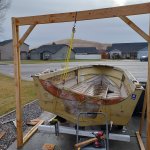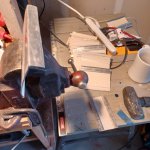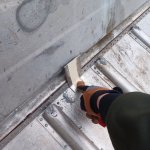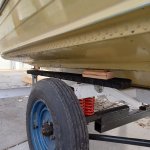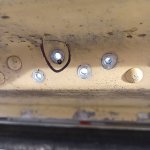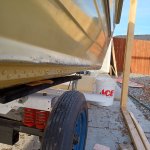Sharpie223
Petty Officer 2nd Class
- Joined
- May 24, 2021
- Messages
- 183
Got a 68 offshore back in March, officially starting the restoration now that the floor is out. Luckily there is no rib/chine cracking, but I do have a beat up portion of the spray rail that I will need to beat back into shape and reinforce. Very little in the way of corrosion, I think this was a freshwater only boat. Previous owner indicated that there was some leakage, about a gallon per trip, however long that equates to, unfortunately his fix was to "seal it up real good with silicone". I will be looking for any loose rivets and plan to seal with gluvit on one side and coat-it on the other, haven't decided which side is which, if anyone has some thoughts on that?
I am about ready to start rib/chine/spray rail reinforcement, does anyone have thoughts about where in the boat cracking is most likely to occur? I figure I can give extra reinforcement there. Main reinforcement will be tabs between ribs plus 1.5 or 2" angle spanning the ribs and connected to each plate to tie ribs to interrib spans. Rivets used for the tabs will be closed end pop rivets, aluminum in new locations, 18-8 stainless if used to replace an existing rivet location. The stainless specs show being stronger than aluminum solid rivets and finding help with bucking could be difficult for me, hence the closed end pop rivets.
This will be a fishing/family boat. Major mods planned are to shorten the splashwell, add folding jumpseats or a bench seat to the back and make the open bow more like a modern fish/ski boat without the walkway.
Engine is a 97' suzuki 75hp, got me alone going ~37 mph until it trimmed to far and started alarming, it runs great but I might work on attempting greater speed once the boat is restored, mostly playing with prop selection but I might try a low water pickup to accommodate higher trim.
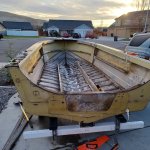
I am about ready to start rib/chine/spray rail reinforcement, does anyone have thoughts about where in the boat cracking is most likely to occur? I figure I can give extra reinforcement there. Main reinforcement will be tabs between ribs plus 1.5 or 2" angle spanning the ribs and connected to each plate to tie ribs to interrib spans. Rivets used for the tabs will be closed end pop rivets, aluminum in new locations, 18-8 stainless if used to replace an existing rivet location. The stainless specs show being stronger than aluminum solid rivets and finding help with bucking could be difficult for me, hence the closed end pop rivets.
This will be a fishing/family boat. Major mods planned are to shorten the splashwell, add folding jumpseats or a bench seat to the back and make the open bow more like a modern fish/ski boat without the walkway.
Engine is a 97' suzuki 75hp, got me alone going ~37 mph until it trimmed to far and started alarming, it runs great but I might work on attempting greater speed once the boat is restored, mostly playing with prop selection but I might try a low water pickup to accommodate higher trim.





















